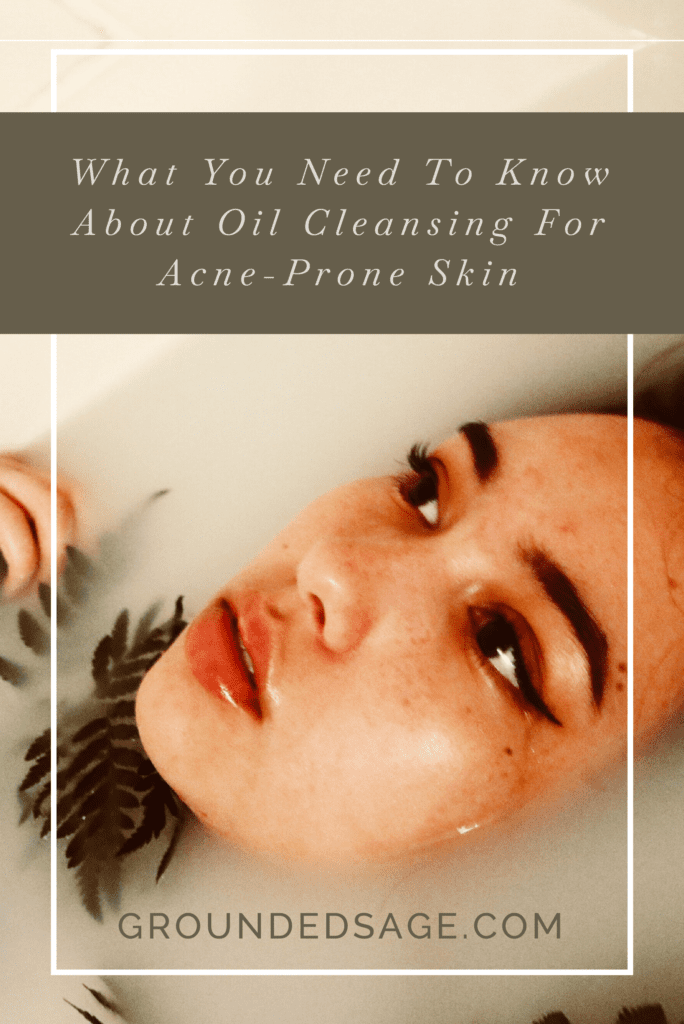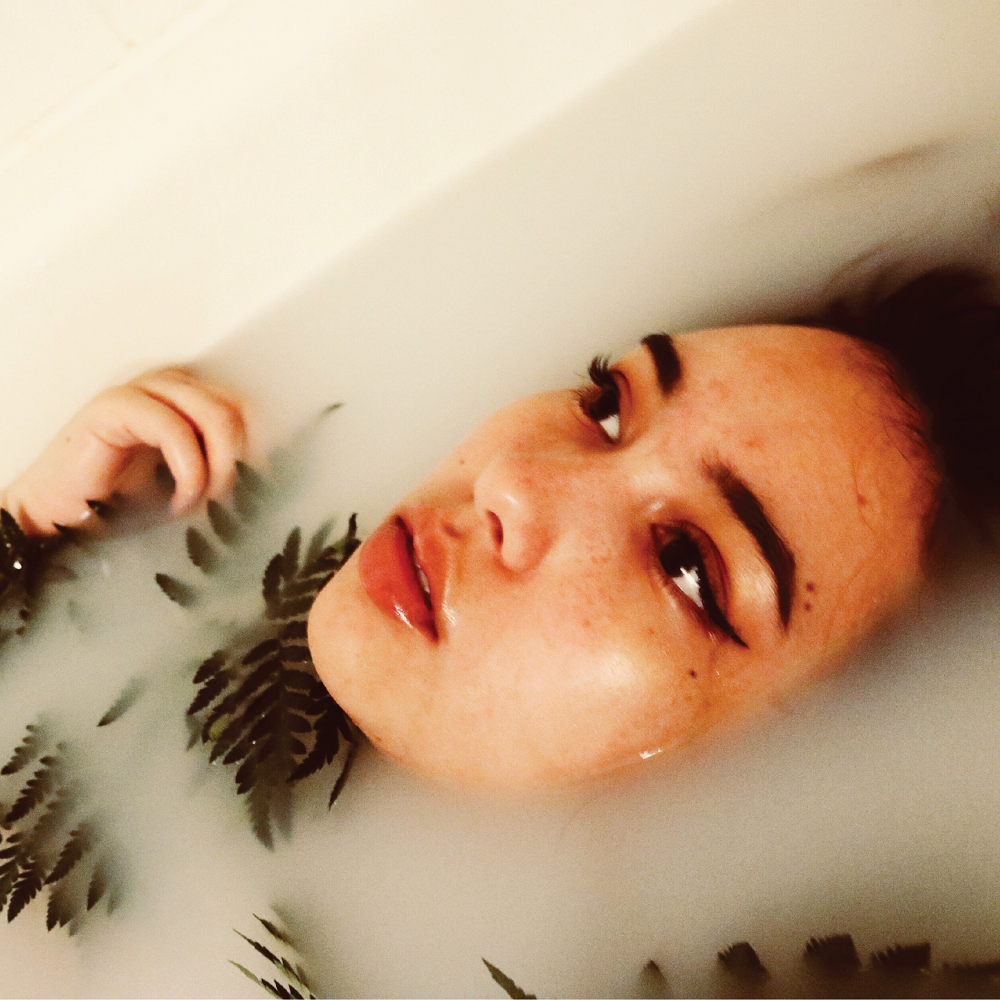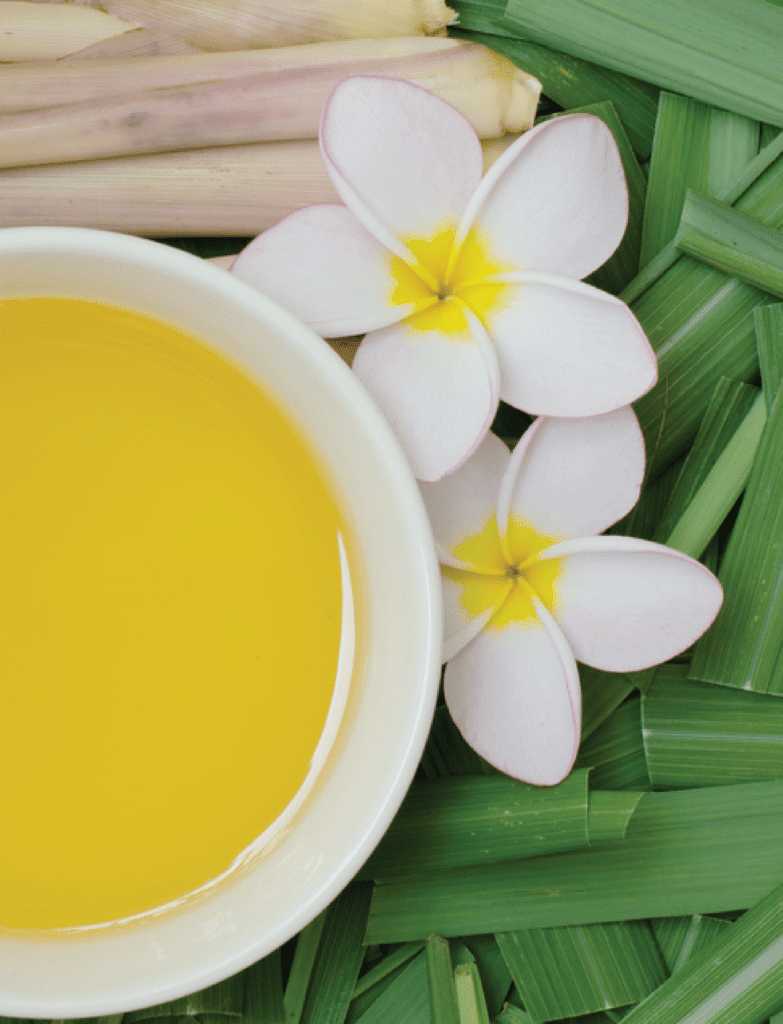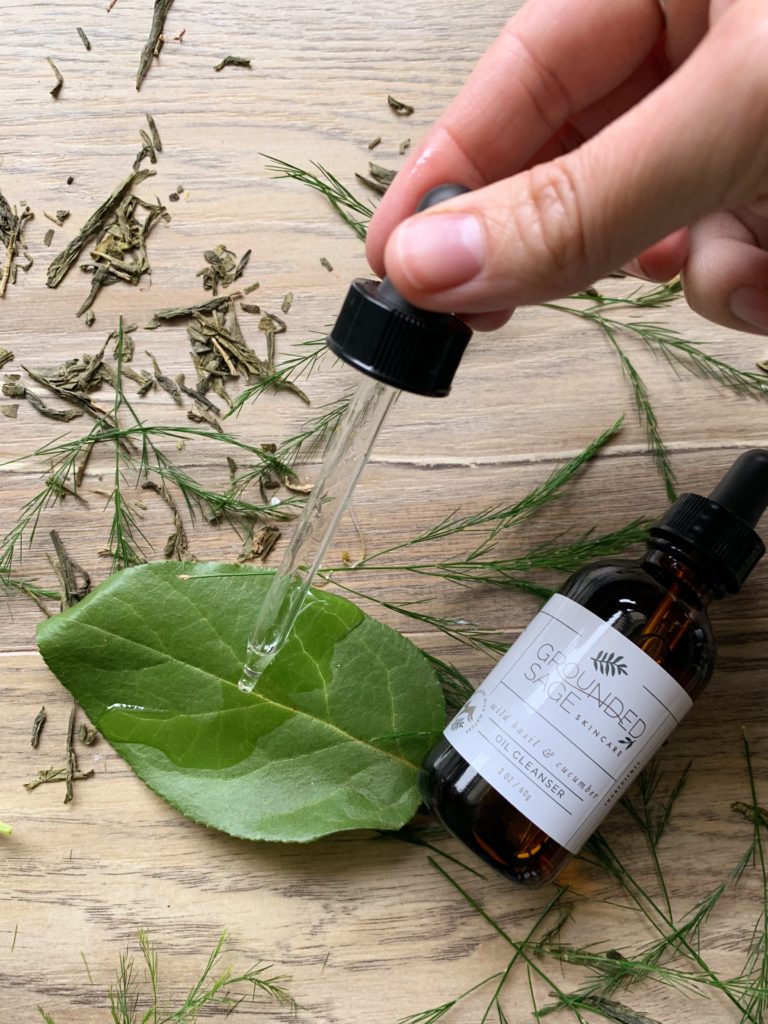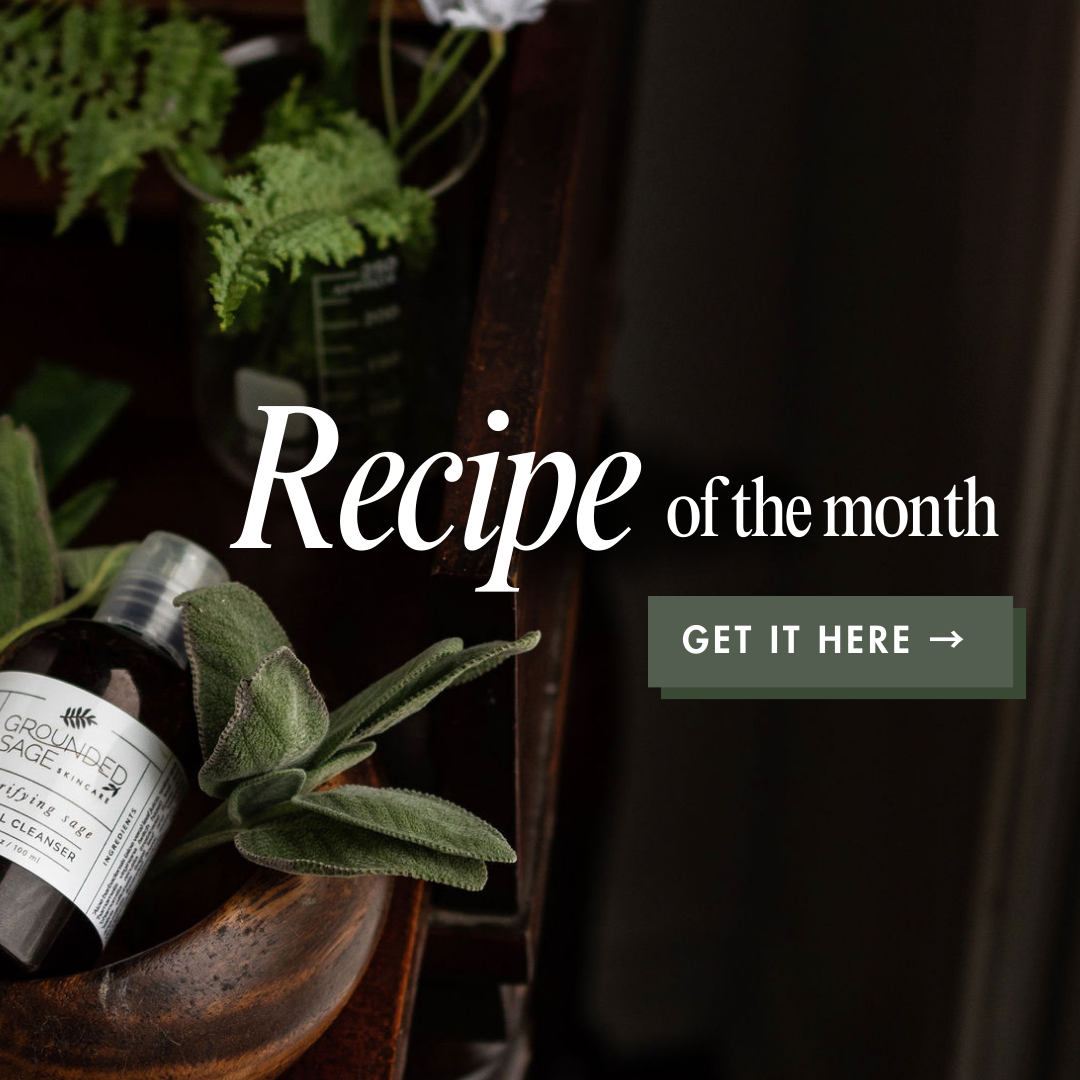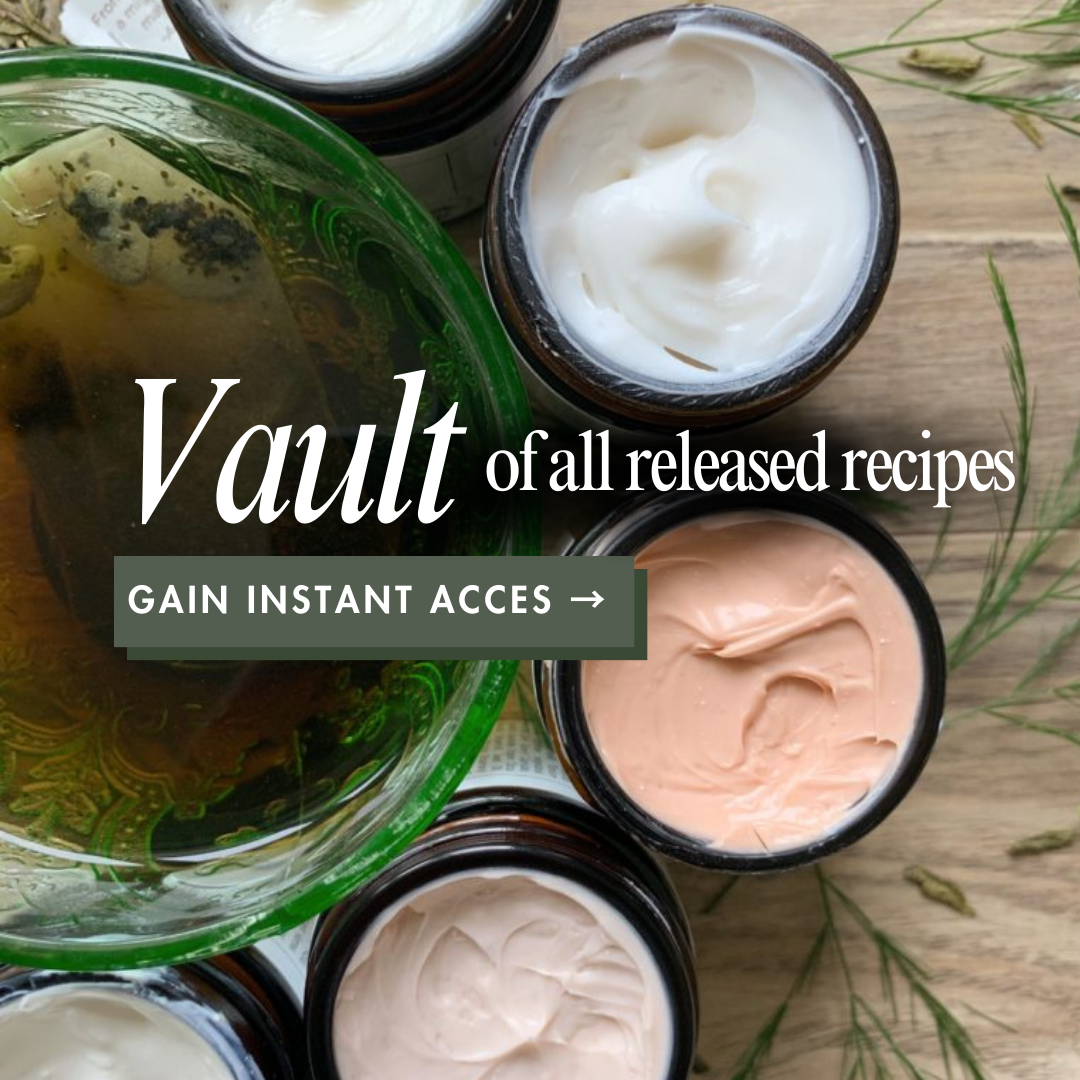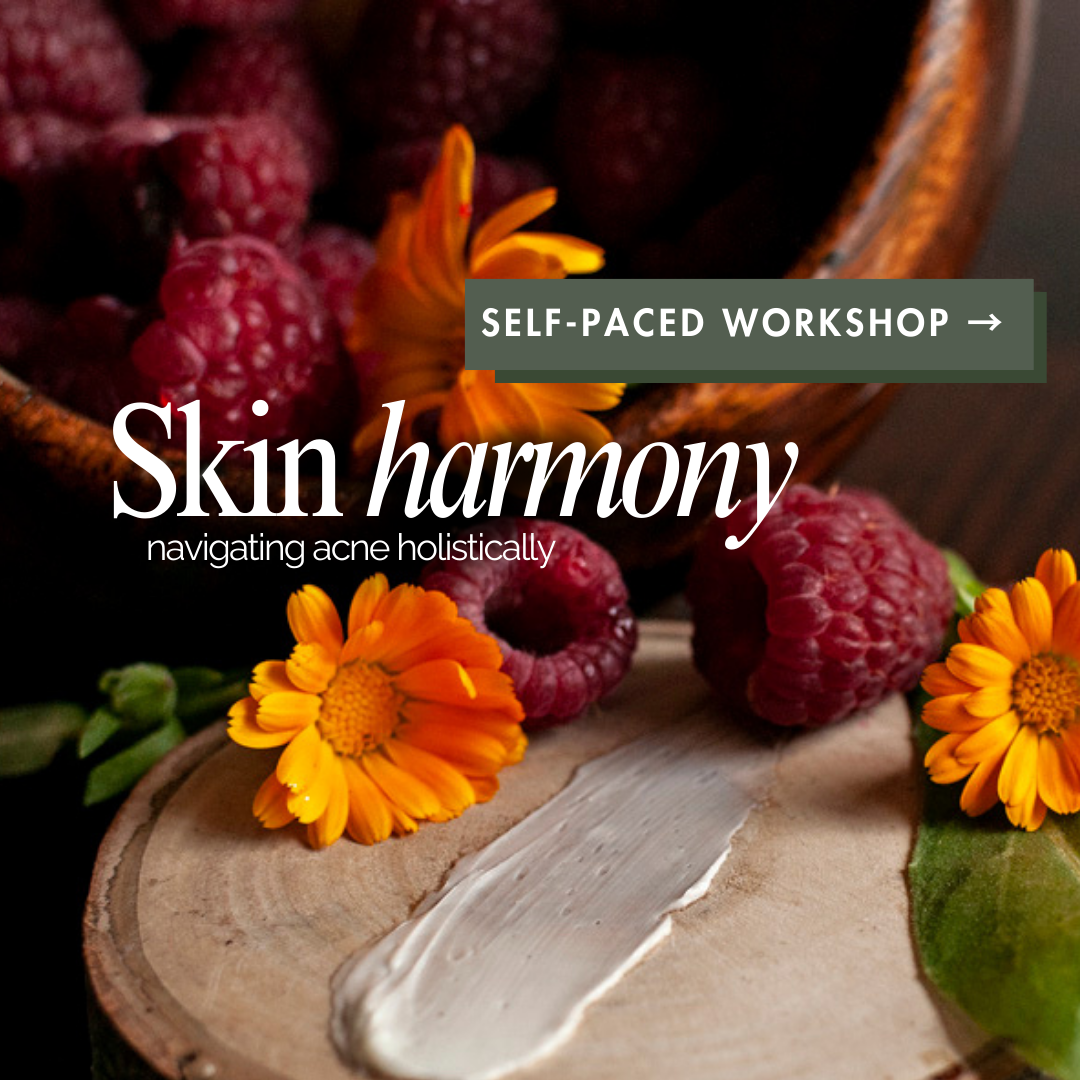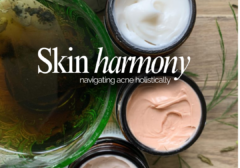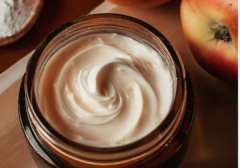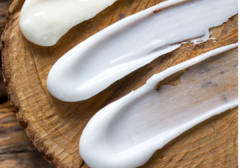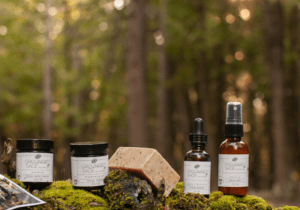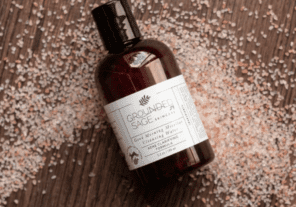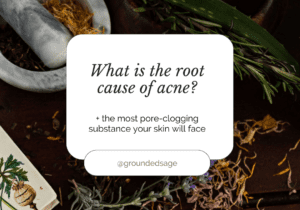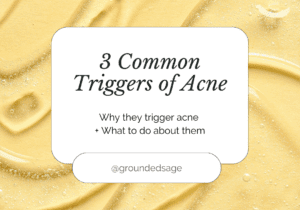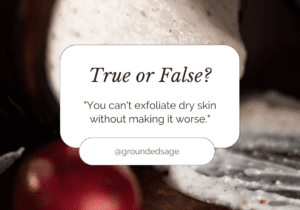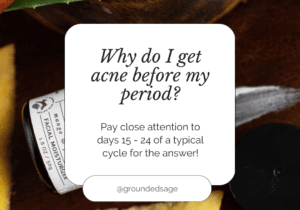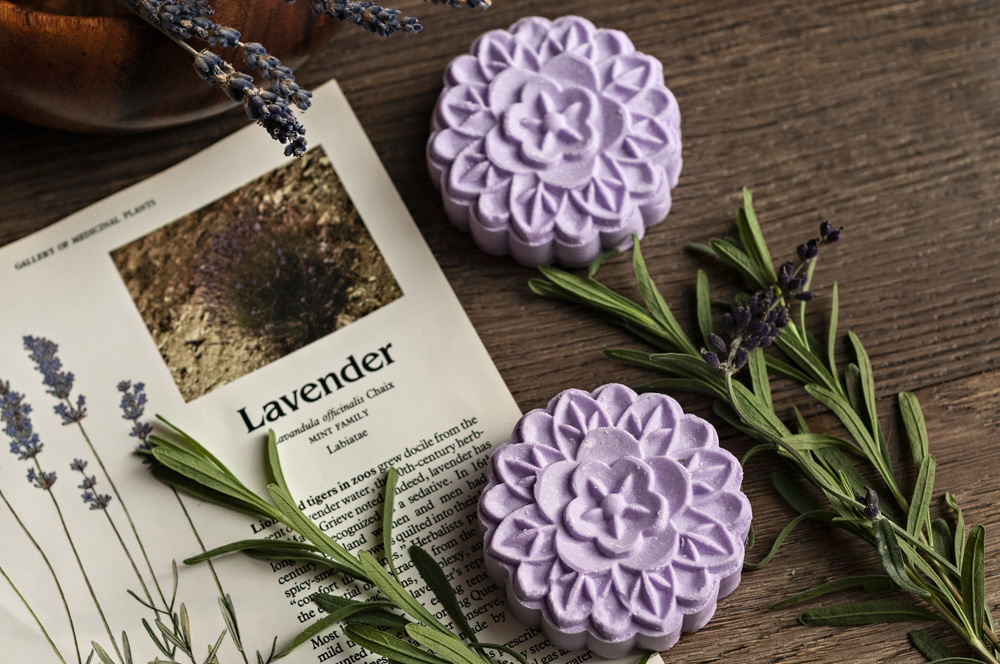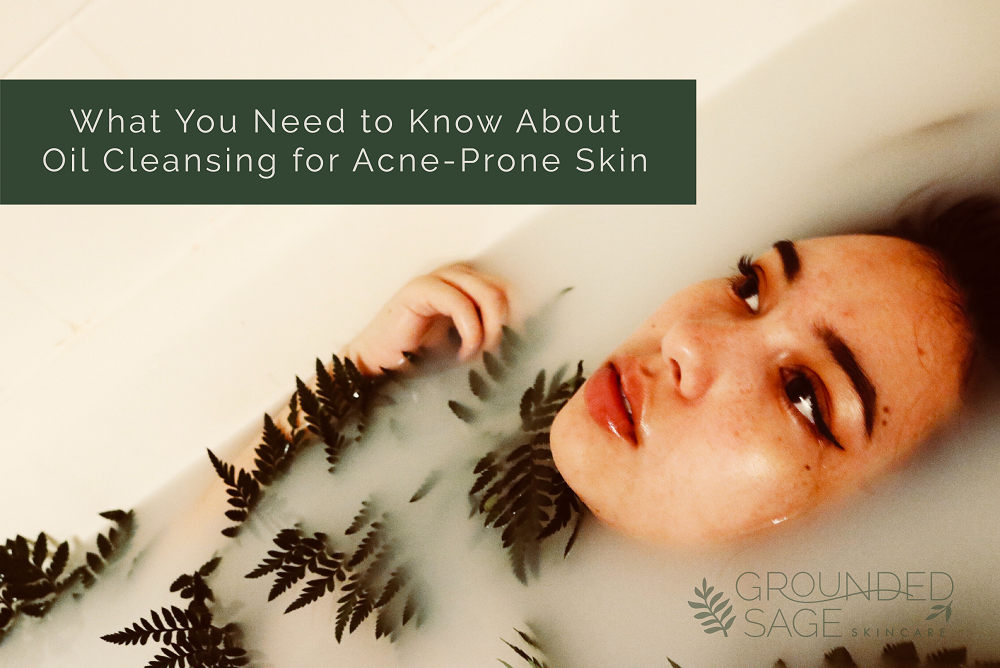
Oil cleansing has been getting a lot of press lately, but does it live up to the hype? And is it something that acne-prone Radiant Rebels, like myself, should be working into our routine? Stick around – that’s what I’m going to help you decide.
Before we dive into oil cleansing, you may want to check out my previous article dedicated to finding the right cleanser for acne prone skin in 3 steps. It’s a must-read for anyone who wants to narrow down surface level triggers of their acne (I reveal 5 triggers and show you how to figure out if any of those 5 triggers are aggravating your skin).
Now on to the main event…
 First up, what exactly IS oil cleansing and the theory behind it?
First up, what exactly IS oil cleansing and the theory behind it?
The bottom line? Using plant-based oils as your cleanser. Literally, it’s blending a couple (or more) oils together, applying the blend to your face, massaging it around, possibly applying a warm damp face cloth to your face for a few seconds, and then wiping off the oil blend. That’s it in a nutshell. It’s one of those super simple concepts, yet it creates a fair amount of confusion since it’s so different from what many of us are either currently doing or, have been doing our whole life when it comes to washing our face.
So how exactly are oils supposed to clean your face?
Oil cleansing is based on the “like dissolves likes” concept. Meaning, the plant-based oils dissolve the natural oils on our skin (our sebum) that has hardened into a clog or plug inside the pore. In other words, when our natural oils haven’t ended up nourishing our skin and, have instead got caught up on dirt or debris while trying to exit our pore, which then leads to them drying up / hardening into an actual blockage inside our pore.
This is a particularly appealing approach to those who experience a lot of congestion and blackheads.
The theory also continues along the “like dissolves like” and “like attracts like” concepts stating that when we wash our face with water-based cleansers, the water gets repelled away from the oil (sebum) plugs (as oil and water don’t mix), where plant-based oils will mix with your own, natural oils (again, your sebum). This mixture of the oil you’ve applied to your face, and the oil that was already there, will be lifted away when the mixture is wiped away with a damp washcloth.
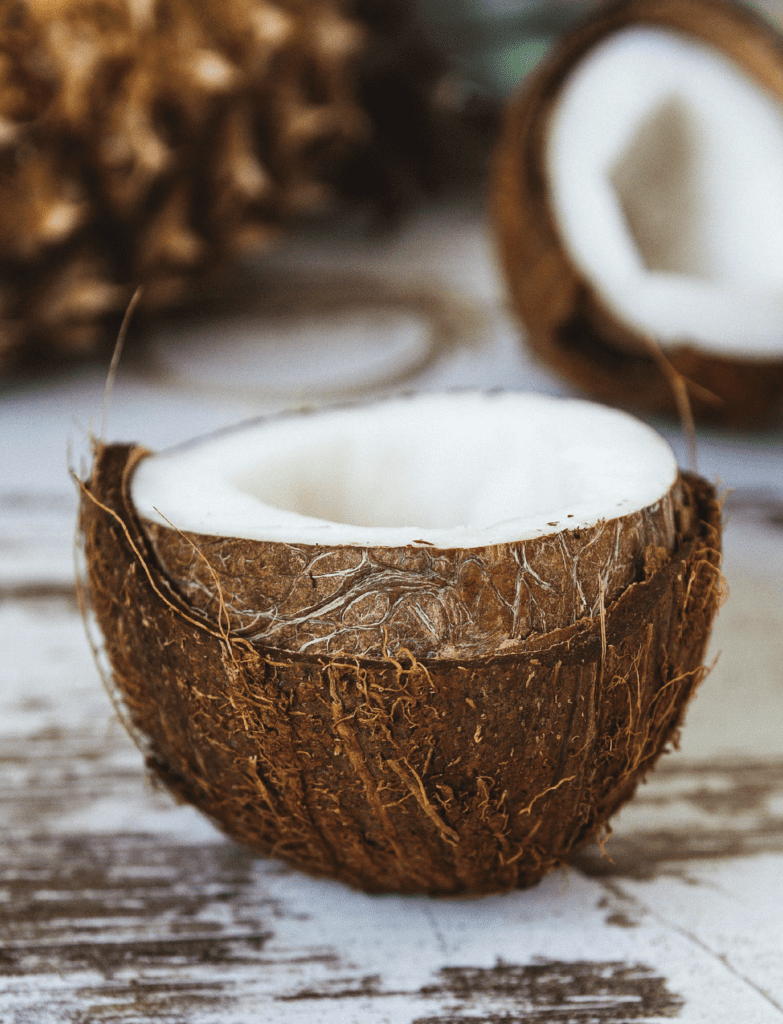
 “Hold up! Wait, wait, wait… But I thought that oil (in all its forms) was supposed to be avoided at all costs! Aren’t the ‘experts’ always telling people who have acne prone skin to run screaming in the other direction from anything that’s oil based? In fact, I’m sure my skin would have a major freak out if I even LOOKED at anything with oil in it, yet alone slathering oil onto my whole face!”
“Hold up! Wait, wait, wait… But I thought that oil (in all its forms) was supposed to be avoided at all costs! Aren’t the ‘experts’ always telling people who have acne prone skin to run screaming in the other direction from anything that’s oil based? In fact, I’m sure my skin would have a major freak out if I even LOOKED at anything with oil in it, yet alone slathering oil onto my whole face!”
Oh, girl! There’s a lot to break down here but, as you may know, my favourite thing to do is break down what we’ve been told all our lives about anything skin related and see if those beliefs/theories/perceptions actually hold up in the light of day!
So let’s do this…
I know many of us (me included, before I dove head deep into the skin care truth pond) have been taught to not only avoid oil, with well-meaning advice like “only use oil-free products”, or in extreme cases, to outright fear oil with cautionary tales (“don’t ever put any form of oil on your face. It will make it explode with zits!”) and skin care tutorials that teach us how to remove every last ounce of oil from our skin. After all, stopping oil from ever even being produced by our body is the premise for modern medicines “cure” (along with an ocean of side effects) for acne, Accutane.
But, here’s the truth: oil isn’t the bad guy! Yes, excess oil is what acne bacteria feed on, but we can’t have healthy skin without oil! Kinda annoying how that works right? The good news is you don’t need to eliminate every last drop of oil from your face to keep acne bacteria from calling all its buddies over for a major feast!
In fact, oil has gotten an unjustified, bad rap. Truthfully, oil is more beneficial than it is harmful! I like to think of oil as being a poor, misunderstood underdog, just like all those beautiful wildflowers that get called “weeds”.
 Let’s take a minute to look out where & when oil’s reputation was villainized.
Let’s take a minute to look out where & when oil’s reputation was villainized.
The term oil-free cropped up around the time that using mineral oil in beauty products was starting to be questioned – especially for acne prone skin. Big brands started to listen, removed mineral oil from some of their formulas and called the new, mineral oil free formulas “oil-free”. Acne sufferers rejoiced over the removal of mineral oil.
The removal of mineral oil was a very good thing, as it’s not like the plant-based oils I love so dearly. Nope, mineral oil has a plethora of reasons to avoid it including the fact that untreated and mildly treated mineral oils are known (thanks to a body of research) to be human carcinogens.
Another reason to avoid mineral oil is how pore clogging (comedogenic) it is – especially the less refined varieties. Some of you have probably heard me talk about ingredients that act like plastic wrap on your face (I.e. No beneficial ingredients can go in and no substances your skin is trying to purge can come out).
While we’re on the subject, and before we move on, one last reason mineral oil is ding dang scary. Just for the record: to list all the reasons to avoid mineral oil would take a whole multi-part series on the blog, so I’m just sticking with a few of the top reasons here. And the last reason I’m mentioning is no less important than mineral oil being a carcinogen or it being pore clogging but, it’s a biggy for those suffering from hormonal acne or any sort of wacky hormone situation (like endometriosis or PCOS for example).
Mineral oil is linked to estrogen dominance (hello one of the root cause of acne), thanks to being classified as a xenoestrogen.
Please stay with me while I give you a quick summary of why this is such a big deal!
As you know, our hormonal system (ie our endocrine system) is an intricate system that has a huge impact on our overall health. Our hormones are our body’s messengers that tell it what to do, when to do it, and how to do it. This goes for everything from when we get hungry, when and how well we sleep, what our menstrual cycle looks like (how long, how often, how horrible… Or not), etc.
 This sensitive system of communication can get all muddled up (like a game of 6th grade “telephone” when the phrase “Jamie has 3 cute rescue dogs that she loves very much” turns into “space cowboy monkeys delivered mermaids on the 4th of July” by the end. Lol). And while it’s funny in a game of telephone, it’s disastrous within our body!
This sensitive system of communication can get all muddled up (like a game of 6th grade “telephone” when the phrase “Jamie has 3 cute rescue dogs that she loves very much” turns into “space cowboy monkeys delivered mermaids on the 4th of July” by the end. Lol). And while it’s funny in a game of telephone, it’s disastrous within our body!
Xenoestrogens, like the ones found in many plastics (which is one of the main reasons we package our skin care in glass) and parabens (again, one of the big reasons why we’ll always make paraben-free products), mimic estrogen which confuses the body as to how much estrogen it needs to be making. It also has effects on other hormones that are affected by how much estrogen is in our system.
 In simplest terms, when xenoestrogens enter the body they increase the total amount of estrogen in our body. This causes what’s called estrogen dominance.
In simplest terms, when xenoestrogens enter the body they increase the total amount of estrogen in our body. This causes what’s called estrogen dominance.
Estrogen dominance can show up in a whole host of crappy symptoms (insomnia, super sore boobs at certain times in your cycle, dry eyes, allergies, forgetfulness – like walking into a room and going “now what did I come in here for?!”, headaches, inflammation, and about 3 dozen other symptoms – at least) and is indicated in numerous conditions, diseases and disorders (just to name a few of the many estrogen dominance is linked to: infertility, endometriosis, miscarriages, diabetes, and several cancers including breast, prostate, and testicular).
And here’s the thing – xenoestrogens, are not biodegradable and build up in our body by being stored in our fat cells. This is what makes their repeated exposure so harmful.
But back to our discussion about mineral oil (which contains the xenoestrogens that cause estrogen dominance)…
You can see, from the detour into 3 of the reasons to avoid mineral oil, why people were so excited for the removal of mineral oil from many beauty products.
However …
That excitement, for those in the know, was short lived.
You see, the removal of mineral oil brought about the (marketing) term “oil-free“. As I mentioned above, this was in reference to the product being free of mineral oil – which we know, is bad. However, the term “oil-free”, as mineral oil became a dated ingredient that wasn’t used as often, came to mean something else entirely. Products that were free of mineral oil were still being labelled “oil-free” but those who didn’t know the background summarized that “oil-free” was the way to go for acne care without realizing that “oil-free” referred to mineral oil – not all oils. Before you knew it, oil – in all its varieties – was villainized and touted as the big bad guys in the fight against acne. This is particularly unfortunate as many plant-based oils help fight acne with anti-bacterial properties, the ability to soothe inflamed and irritated skin, and deliver a dose of healing nutrients to acne-plagued skin.
And here’s the real kicker…
Mineral oil is a by-product of petroleum (keep that in mind while I reveal what mineral oil was replaced with). Mineral oil was removed to make way for other petroleum-based ingredients – which means we’re back to square one people! Ugh!
Swapping mineral oil for another by-product doesn’t solve any of the reasons mineral oil needed to be removed in the first place! The problem is still there, it’s just under another name.
Let me put it this way, switching out mineral oil for another petroleum-based ingredient is like someone who needs to avoid dairy products asking to have a hot chocolate made with water instead of milk, but then topping it off with heaps of whipped cream! Using water in place of milk didn’t make the drink dairy free after finishing it off with whipped cream.
But let’s get back to oil cleansing …
Now that we know oil cleansing isn’t using mineral oil, or any other pore clogging, carcinogenic, estrogen-mimicking substance, let’s take a look at what oils are used in the oil cleansing method and whether or not these should be avoided too (particularly when it comes to acne prone skin).
Based on what we learned in our history lesson above, the question you may be asking yourself now is…
Does the notion that “oil-free” is better when it comes to acne prone skin still apply?
In a nutshell?
When “oil-free” refers to mineral oil, absolutely.
When it comes to plant-based oils, absolutely not.
It’s my hope that by the end of this article you’ll see that oils aren’t all created equal and that it can’t be assumed that “oil-free” is better, or even advisable when it comes to skin care. Broad, blanketed statements and assumptions like that rarely get us anywhere.
Just like applying negative stereotypes to specific breeds of dogs is detrimental to not only those breeds but our communities at large (but that’s for another post), using “oil-free” as a quick memory trick when making decisions about beauty products can be detrimental to your skin.
And here’s why: Oil isn’t the be all and end all of the acne formation or causation. Other factors are involved and are in fact, issues before the oil even comes into the picture (such as skin cell turn over, sticky cells, inflammation, etc).
 There are two types of oils your skin actually benefits from:
There are two types of oils your skin actually benefits from:
it’s own, natural oil (sebum) and plant-based oils.
We’ll get into all the benefits of our oils in another post, but for now, let’s explore exactly why our skin loves plant-based oils so much!
Plant-Based Oils: Why They Are Your Skin’s BFF.
So a discussion about oil cleansing, and whether or not it should be included in an acne busting routine, wouldn’t hold much weight without discussing the oils!
Listing all the benefits of plant-based oils for our skin is beyond the scope of this already lengthy post, so let’s zero in on just a few of the benefits that are acne specific.
Bye Bye Bacteria
 P.acnes bacteria loves oil, more specifically, the oil our body produces (sebum)! This is one of the (secondary) reasons I believe oil has gotten a bad rap. The more sebum on our face, the more P.acne bacteria has to feast on!
P.acnes bacteria loves oil, more specifically, the oil our body produces (sebum)! This is one of the (secondary) reasons I believe oil has gotten a bad rap. The more sebum on our face, the more P.acne bacteria has to feast on!
Which is why ensuring our oil production is balanced – not too much (bacteria smorgasbord) and not too little (Sahara dessert like skin which equals dehydration, which equals build up in pores, which equals acne!).
Since P.acnes loves oil, it gathers in areas that are abundant in oil. So why add more oil to the party? Well, remember at the top of this post where we reviewed the theory behind oil cleansing? Where our natural oil gets mixed with the plant-based oil? Well, this is awesome because not only is P.acnes attracted to oil (so it comes running when you oil cleanse), but it’s also been hanging out with your own oil. What it doesn’t realize, as it’s swimming around and having a pool party in our oils, is that the plant-based oil has arrived carrying one very important party favour: antibacterial properties!
P.acne’s fun is ruined when it gets wiped out by the antibacterial properties contained in the plant-based oil!
Some plant-based oils that are particularly high in astringent properties include hazelnut and grape seed.
Reverse The Oil Slick
 Introducing more oil to our face (albeit plant-based) combats oily skin! Say whaaaat?!
Introducing more oil to our face (albeit plant-based) combats oily skin! Say whaaaat?!
It’s true! Our oil production can be adjusted in two ways: internally and externally. Both are equally important.
How do we adjust our oil production externally?
Regulating oil externally is a delicate balance of providing your skin with exactly what it needs for the outer most layers of skin (where acne happens) to be healthy and clear.
When the skin feels like it has enough protection, and it’s natural lipid (oil) barrier isn’t compromised, it responds by downregulating oil (sebum) production. If it doesn’t feel adequately protected (like when it’s been stripped or dehydrated), it responds by increasing oil production.
So how can we ensure our skin it’s protected?
We can do this daily with a balanced routine, particularly one that includes plant-based oils and a good dose of hydration. Plant-based oils can be worked into your routine in numerous ways. Any step in your routine can include plant-based oils: from your cleanser to your moisturizer to your boosting products like mists, serums, and masks.
Plant-based oils are particularly good at reversing the oil slick because they contain essential fatty acids which help repair our lipid barrier (our skin’s defence system) and antioxidants (that stop free radicals from causing more damage).
– GLA (a type of omega 6) corrects deficiencies in our oils which is super important when trying to reassure our skin that it doesn’t need to kick oil production into high gear. Borage oil and evening primrose oil are both particularly high in GLA.
– Palmitoleic Acid (omega 7) helps repair damage by providing additional support to our skin. How? palmitoleic acid is a component of skin (a building block of healthy, radiant skin!) so the skin goes to work quickly in putting it to work repairing and calming any current damage. Sesame oil and sea buckthorn oil are both excellent sources of palmitoleic acid.
Beauty Building Blocks
 Lastly, plant-based oils give our skin a serious boost by providing some of the necessary building blocks it needs to do its vital jobs (like being the first line of defence for our immune system).
Lastly, plant-based oils give our skin a serious boost by providing some of the necessary building blocks it needs to do its vital jobs (like being the first line of defence for our immune system).
Collagen, which is the most important building block for our skin (if our skin was a house, collagen would be the load-bearing walls) and plant-based oils can provide our skin with some of the building blocks it needs to build collagen.
Avocado oil is known for its ability to trigger the skin to increase collagen (and that’s a very good thing)!
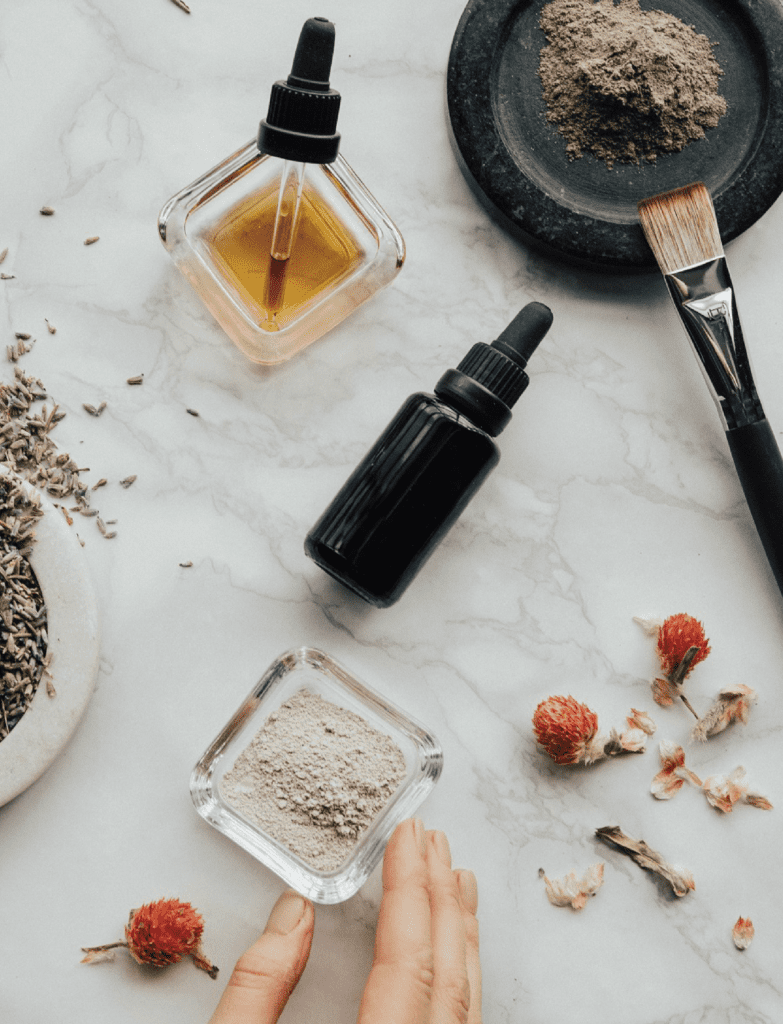
As you can see, the benefits of plant-based oils can’t be ignored.
Who wouldn’t want to provide their skin with so much nourishing support?
I, for one, wouldn’t want to see what my skin would look like without all the nourishment it gets from a daily dose of plant oils.
But, we return back to the question…
Is oil cleansing right for acne prone skin?
If you’re currently using a serum, mist, mask, or moisturizer with plant-based oils, you’re already feeding your skin all the benefits that we listed above including busting bacteria, regulating oil production, and dosing your skin with essential building blocks.
So do you really need to increase that dose with oil cleansing?
That’s where I can’t give you a straight answer as this is going to be a personal preference and will depend on how your skin is responding right now to a balanced facial routine. If you aren’t sure you currently have a supportive skin care routine, you can double-check (or build one quickly) right here.
Addressing the (temporary) downside & troubleshooting
To say that oil cleansing is all unicorns and rainbows would be clouding over one downfall that could be enough for you to want to skip introducing it into your routine, at least until your skin is in a pretty good place and you know the specific causes and triggers that send your skin into a tailspin.
The downfall is what’s referred to as detox reactions.
Now keep in mind, these are generally minor reactions and any routine that will help your skin purge itself of debris, toxins, and impurities can have this effect.
Minor detox reactions refer to a slight increase in breakouts as oil issues are resolved and deeper oils that have hardened are brought to the surface. This usually occurs for 1 – 3 weeks and gradually decreases in severity.
So how do you minimize (and in many cases completely avoid) detox breakouts when including oil cleansing in your routine?
First, start out deciding if a well-formulated cleanser that addresses your skin’s specific triggers would do the trick. I would advise all Radiant Rebels to start here by narrowing down their triggers, picking a cleanser or cleansers that address those triggers, and work those cleansers into a well-balanced routine. Follow that routine for at 6 – 8 weeks before deciding if oil cleansing is something you want to try.
Second, if you haven’t been following a green beauty, balanced routine for 6 – 8 weeks prior and really wanted to dive into oil cleansing, at least put the breaks on for 4 weeks to do a skin detox – that is, if you want to minimize your chances of detox breakouts from oil cleansing. While you may also experience some detox breakouts during a skin detox, those are generally much milder than the initial oil cleansing breakouts that show up for those who are jumping right from traditional / drugstore skincare routines. If you decide to do a skin detox, like our detox skin care kit, before making a decision about oil cleansing, the best ways to reduce any detox reactions is to include the right hydrator into your routine and after washing your face. Apply it each and every time. This quiz will show you the right hydrator for you.
Third, use the right oils. There are so many different plant oils that can be used when oil cleansing, and narrowing down the right ones for your skin can get tricky fast! Not only do you want to make sure you’re using oils that are low on the comedogenic scale (that’s a rating system for ingredients based on how likely they are to clog pores based on “typical” skin properties). You also want to make sure you’re picking oils that address your particular triggers – a.k.a. the things that cause your skin to become unruly – so you’re getting the maximum benefit from your effort. As well as oils that avoid your triggers – there’s nothing worst than taking one step forward just to take two steps back!
Because I know trying to navigate this stuff can get tricky, confusing, and downright frustrating fast, my best advice is to go with a blend that’s already been customized – and proven to work for – specific concerns.
If you decide to dive into the world of oil cleansing and have acne-prone skin, I highly recommend trying a cleansing oil that is formulated specifically for acne-prone skin. Check out the ingredients in ours below!
When working a cleansing oil into your routine for the first time, it’s not a bad idea to give a double cleanse a go until you get the hang of it. This secondary cleanse should be done with a mild, trigger-specific cleanser after using a cleansing oil. To find your trigger-specific cleanser, head over here.
A Natural Non-Comedogenic Cleansing Oil for Acne
It doesn’t take long after adding an expertly crafted oil cleanser to your routine to fall in love with how easily excess oils, makeup, and sunblock is dissolved and rinsed clean from the skin without the use of any harsh or stripping ingredients.
Our unique blend of non-greasy, silky feeling, non-comedogenic plant-based oils is extremely gentle on the skin, calms acne and redness-prone skin with nourishing antioxidants, and doesn’t strip away existing moisture.
We took special consideration to address congestion, clogged pores and dehydrated skin with this natural, plant-based cleanser. It gently unclogs pores, lifts impurities, and leaves the skin soft and lightly moisturized.
Let’s have a look at the oils we used in our cleansing oil and why!
Grounded Sage Skincare:
Wild Basil & Cucumber Oil Cleanser
Perilla Oil (Aka Wild Basil)
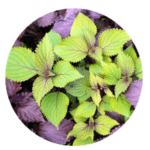 Perilla oil is known for its high levels of essential fatty acids that soothe skin, keep sensitive skin calm, and supports a healthy lipid barrier. Those essential fatty acids and antioxidants also help support our skin in the face of environmental stressors and protect against free radical damage. But why include it in a cleanser? Because Wild Basil is considered to be one of the very best plant-oils for minimizing the appearance of large pores, reducing excess sebum production, and gently cleansing the skin.
Perilla oil is known for its high levels of essential fatty acids that soothe skin, keep sensitive skin calm, and supports a healthy lipid barrier. Those essential fatty acids and antioxidants also help support our skin in the face of environmental stressors and protect against free radical damage. But why include it in a cleanser? Because Wild Basil is considered to be one of the very best plant-oils for minimizing the appearance of large pores, reducing excess sebum production, and gently cleansing the skin.
Safflower Oil
 Safflower oil contains a unique blend of essential fatty acids and antioxidants that is high in linoleic acid which makes it a gentle, deep cleansing oil that works to break up blackheads and other impurities in the skin. It’s also high in vitamin E (a powerful antioxidant that supports our skin against free radical damage), helps to minimize inflammation on the skin (making it great for sensitive and acne-prone skin), and leaves the skin feeling soft and smooth.
Safflower oil contains a unique blend of essential fatty acids and antioxidants that is high in linoleic acid which makes it a gentle, deep cleansing oil that works to break up blackheads and other impurities in the skin. It’s also high in vitamin E (a powerful antioxidant that supports our skin against free radical damage), helps to minimize inflammation on the skin (making it great for sensitive and acne-prone skin), and leaves the skin feeling soft and smooth.
Cucumber Seed Oil
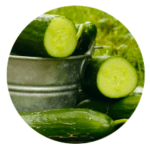 Cucumber seed oil leaves the skin feeling refreshed, smooth, fresh, and shine-free. Its high antioxidant content (including vitamin E) helps soothe acne and sensitive skin inflammation and redness. Its high phytosterol content adds an extra dose of support for the skin’s lipid barrier.
Cucumber seed oil leaves the skin feeling refreshed, smooth, fresh, and shine-free. Its high antioxidant content (including vitamin E) helps soothe acne and sensitive skin inflammation and redness. Its high phytosterol content adds an extra dose of support for the skin’s lipid barrier.
Elderberry Extract
 Elderberry is a super fruit that is packed with antioxidant, anti-inflammatory, antimicrobial and astringent benefits – not only does it help to nourish the skin and keep it calm and balanced, it also offers support to our skin’s microbiome and lipid barrier.
Elderberry is a super fruit that is packed with antioxidant, anti-inflammatory, antimicrobial and astringent benefits – not only does it help to nourish the skin and keep it calm and balanced, it also offers support to our skin’s microbiome and lipid barrier.
So there you have it.
Hopefully, I’ve provided you with the info you need to decide if oil cleansing might be worth trying for your acne-prone skin.
And if you’re wondering if I used oil cleansing during my skin journey to clear skin, the answer is not really. I use oil cleansing to remove my eye makeup and occasionally if I had applied a lot of layers of concealer and foundation to cover up a particularly bad breakout, I’d start with oil cleansing then follow up with a combo of cleansing and exfoliating.
I wanted to make sure you knew that oil cleansing doesn’t have to be a part of your healing journey, and I don’t consider it a part of mine. So don’t feel pressured to jump on the oil cleansing bandwagon if it doesn’t feel right to for you. Oil cleansing is super trendy at the moment but only you can decide what’s best for your skin – and in fact, your skin will be sure to tell you if it doesn’t like your decision lol!
When do I highly recommend oil cleansing? If your acne healing journey has been plagued with dehydrated skin, using a cleansing oil would be at the top of my recommendations!
Until next time,
![]()
Pin this article for later:
